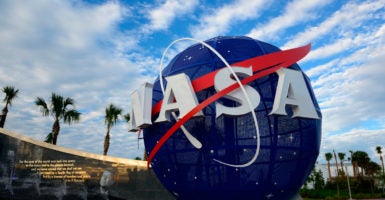HOUSTON—Unvalidated climate models that don’t correspond with physical data and the requirements of the scientific method contribute to unfounded climate alarmism, a retired NASA physicist said at the Heartland Institute’s recent America First Energy Conference.
Since America’s national security depends in part on energy security, unsubstantiated claims about global warming that prevent policymakers from making “rational decisions” with regard to the development of U.S. energy resources have become a national security threat, said Hal Doiron, a 16-year NASA veteran.
The “propaganda” underpinning climate alarmism is “causing tremendous political bottlenecks” that prevent government officials from “doing the right thing” on energy, he said.
Doiron, who helped develop the Apollo Lunar Module’s landing dynamics software during NASA’s moon missions, also expressed concern that the U.S. military has been directly affected by climate alarmist claims separated from sound science.
He criticized the Navy for “preparing for something that is unreasonable and would cost too much money” in the form of “extreme sea-level rise,” which has not been borne out by rigorous scientific study.
Doiron defines unvalidated climate models as those that do not agree with physical data. Public policy and military planning should be based only on models validated by physical data, he said.
“At NASA, we have a policy: You can’t make a design decision on a spacecraft or rocket that is not validated,” he said. “You don’t make critical decisions based on ‘garbage in, garbage out.’ Yet our government has been doing that with respect to climate alarm, because too many academics in universities are writing papers, drawing conclusions from models that don’t agree with physical data.”
Doiron is part of a group called “The Right Climate Stuff,” which includes engineers and scientists from across generations who have taken part in NASA’s most high-profile missions dating back to Apollo.
The group has produced its own “rigorous, earth surface temperature model using conservation-of-energy principles” that operates similarly to the way the surface and internal temperature of a spacecraft is analyzed, the Right Climate Stuff team explains on its website.
The reports produced from the analysis provide more “realistic projections” of the rise in the earth’s surface temperature over the next 150 years that show severe anti-fossil fuel regulations are not justified, Doiron and other former NASA team members contend.
“The scientific method requires that your hypothesis and theories be confirmed by physical data,” he said. “Computer models are not physical data, although I think many in academia don’t understand that.”
When unvalidated models are compared with validated models based on physical evidence, the validated models predict much less global warming, Doiron said. Moreover, the fact that unvalidated models often don’t agree with each other should be a “big, red flag.”
The retired NASA physicist is calling for U.S. policymakers to establish official data on two key metrics; specifically, “the true sensitivity of surface temperature to greenhouse gases” and a “reasonable projection of greenhouse emissions and [the] concentrations rise in our atmosphere.”
Doiron and his team have developed “a new metric” called “transient climate sensitivity,” which measures how much warming can be seen with a doubling of carbon dioxide in the atmosphere in the “way that it’s actually happening,” based on a “very small amount of [carbon dioxide] each year.”
That’s something that can be measured and verified against available physical data, he said. But because policymakers, including military planners, are not operating from reasonable projections, they are not in a position to adequately plan for the future, Doiron cautioned.
Another way climate change alarmism has worked to undermine America’s national security standing is by consuming too much of the military budget at the expense of military readiness, a top naval commander said during the panel discussion.
Adm. Thomas Hayward, who retired from the Navy as chief of naval operations and a member of the Joint Chiefs of Staff after serving as commander of the 7th Fleet and commander in chief of the Pacific Fleet, also addressed the Heartland Institute’s energy conference and sounded concerns.
For the past six to eight years, Hayward said, climate change has been given “a higher priority” than the readiness of the Navy’s fleet. During that time, the Defense Department has spent $100 billion on “just climate change,” while the Navy has spent “$58 billion chasing what is called the ‘green fleet.’”
That means many Navy vessels are using biofuels, but Hayward wonders how many ports around the world are equipped to accommodate Navy vessels that rely on a high percentage of biofuels, and he worries how that would work in a combat situation.
This report has been modified to state correctly how much Hayward said the Defense Department has spent on climate change.
































One Reply to “Climate Change Alarmism Is ‘Garbage In, Garbage Out,’ Retired NASA Physicist Says”